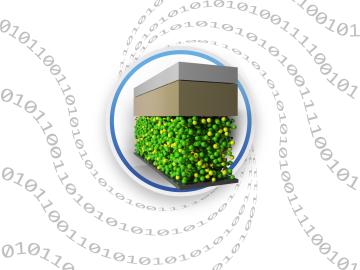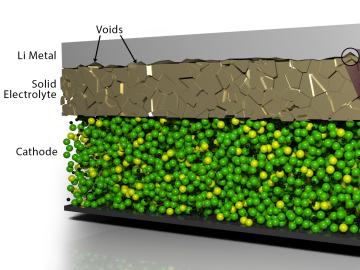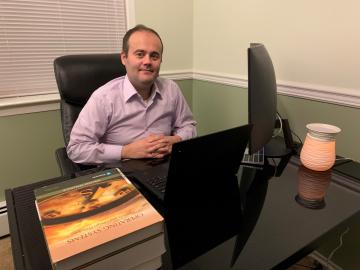
Filter News
Area of Research
- (-) Energy Science (163)
- (-) Neutron Science (32)
- Advanced Manufacturing (10)
- Biology and Environment (80)
- Building Technologies (2)
- Computational Biology (2)
- Computational Engineering (3)
- Computer Science (17)
- Electricity and Smart Grid (1)
- Energy Sciences (2)
- Fuel Cycle Science and Technology (1)
- Functional Materials for Energy (2)
- Fusion and Fission (33)
- Fusion Energy (11)
- Isotope Development and Production (1)
- Isotopes (5)
- Materials (91)
- Materials for Computing (15)
- Mathematics (1)
- National Security (38)
- Nuclear Science and Technology (38)
- Nuclear Systems Modeling, Simulation and Validation (1)
- Quantum information Science (9)
- Sensors and Controls (1)
- Supercomputing (155)
News Topics
- (-) Artificial Intelligence (14)
- (-) Biotechnology (5)
- (-) Composites (18)
- (-) Computer Science (35)
- (-) Energy Storage (74)
- (-) High-Performance Computing (8)
- (-) Machine Learning (10)
- (-) Nuclear Energy (9)
- (-) Quantum Science (8)
- (-) Security (8)
- 3-D Printing/Advanced Manufacturing (83)
- Advanced Reactors (6)
- Big Data (7)
- Bioenergy (31)
- Biology (18)
- Biomedical (20)
- Buildings (38)
- Chemical Sciences (17)
- Clean Water (10)
- Coronavirus (22)
- Critical Materials (9)
- Cybersecurity (9)
- Environment (59)
- Exascale Computing (2)
- Fossil Energy (3)
- Frontier (3)
- Fusion (2)
- Grid (39)
- Hydropower (3)
- Isotopes (1)
- Materials (46)
- Materials Science (48)
- Mathematics (3)
- Mercury (3)
- Microelectronics (1)
- Microscopy (10)
- Molten Salt (1)
- Nanotechnology (17)
- National Security (7)
- Neutron Science (121)
- Partnerships (12)
- Physics (10)
- Polymers (12)
- Quantum Computing (1)
- Simulation (4)
- Space Exploration (6)
- Statistics (1)
- Summit (9)
- Transportation (68)
Media Contacts

ORNL, TVA and TNECD were recognized by the Federal Laboratory Consortium for their impactful partnership that resulted in a record $2.3 billion investment by Ultium Cells, a General Motors and LG Energy Solution joint venture, to build a battery cell manufacturing plant in Spring Hill, Tennessee.

Scientists can speed the design of energy-dense solid-state batteries using a new tool created by Oak Ridge National Laboratory.

More than 50 current employees and recent retirees from ORNL received Department of Energy Secretary’s Honor Awards from Secretary Jennifer Granholm in January as part of project teams spanning the national laboratory system. The annual awards recognized 21 teams and three individuals for service and contributions to DOE’s mission and to the benefit of the nation.

Burak Ozpineci started out at ORNL working on a novel project: introducing silicon carbide into power electronics for more efficient electric vehicles. Twenty years later, the car he drives contains those same components.

Ten scientists from the Department of Energy’s Oak Ridge National Laboratory are among the world’s most highly cited researchers, according to a bibliometric analysis conducted by the scientific publication analytics firm Clarivate.

Researchers at ORNL designed a novel polymer to bind and strengthen silica sand for binder jet additive manufacturing, a 3D-printing method used by industries for prototyping and part production.

Scientists at the Department of Energy’s Oak Ridge National Laboratory have developed a scalable, low-cost method to improve the joining of materials in solid-state batteries, resolving one of the big challenges in the commercial development of safe, long-lived energy storage systems.

A team led by the U.S. Department of Energy’s Oak Ridge National Laboratory demonstrated the viability of a “quantum entanglement witness” capable of proving the presence of entanglement between magnetic particles, or spins, in a quantum material.

Having co-developed the power electronics behind ORNL’s compact, high-level wireless power technology for automobiles, Erdem Asa is looking to the skies to apply the same breakthrough to aviation.

Oak Ridge National Laboratory researchers have developed a novel process to manufacture extreme heat resistant carbon-carbon composites. The performance of these materials will be tested in a U.S. Navy rocket that NASA will launch this fall.


